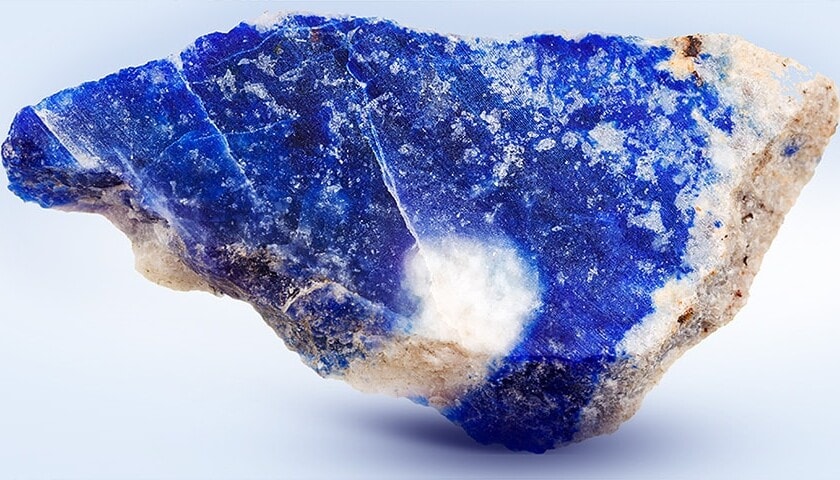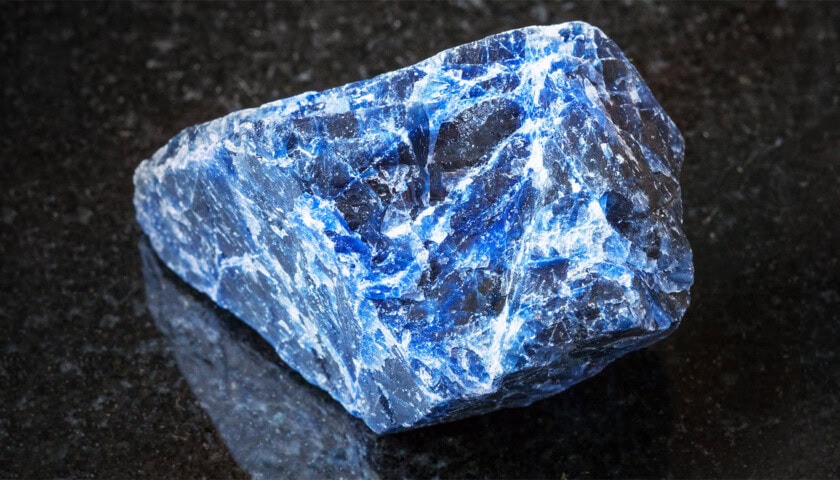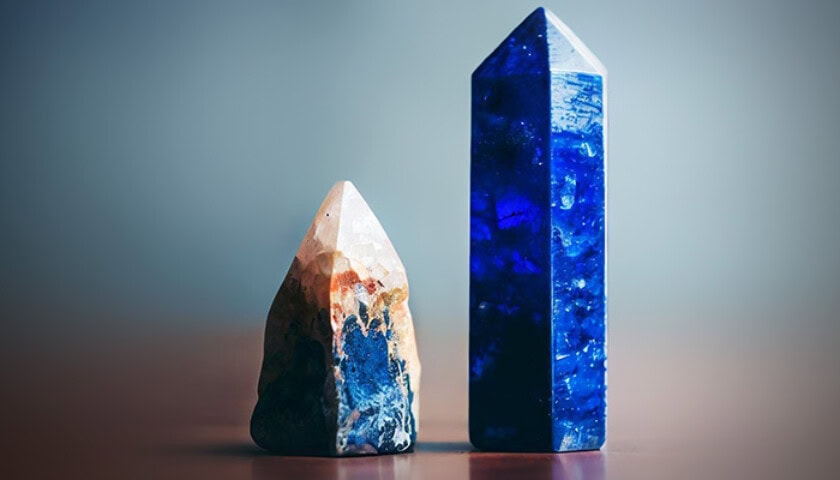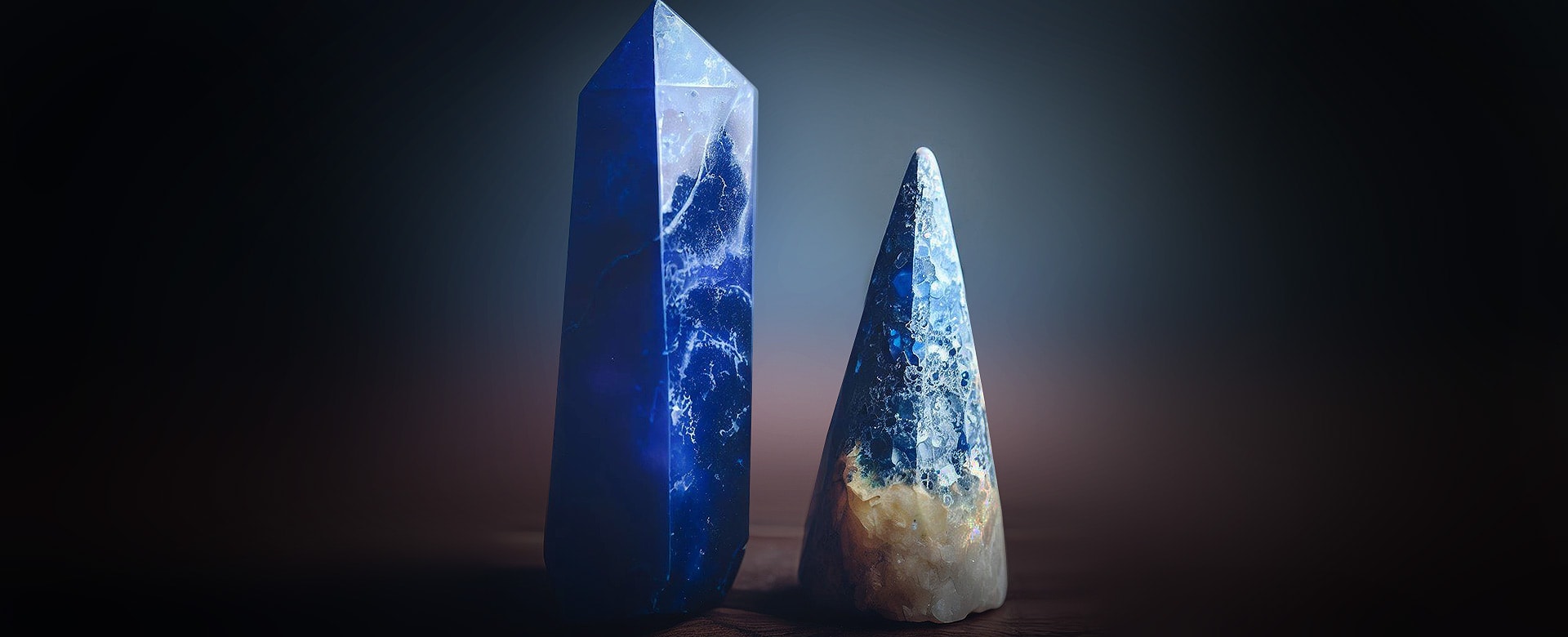Article Highlights
Have you ever wondered about the difference between Lapis Lazuli and Sodalite? Although they are both beautiful blue gems, they have a lot of other defining characteristics that make them excitingly unique. From their metaphysical properties to how they may benefit us spiritually, mentally, and physically – it’s important to understand their nuances. This article will discuss the differences between Lapis Lazuli and Sodalite.
Main Differences Between Lapis Lazuli and Sodalite
What is Lapis Lazuli?
Lapis lazuli is an opaque blue stone used for thousands of years for jewelry and decorative purposes. It comprises a mix of minerals, including lazurite, calcite, pyrite, and diopside. Lapis lazuli has been highly valued throughout history for its deep blue color and unique sparkles from its pyrite inclusions.

What is Sodalite?
Sodalite is a blue to purple-blue variety of the mineral Sodalite, a member of the feldspathoid group of minerals. Sodalite can be found naturally in volcanic rocks or formed as nodules in sedimentary rocks. The stone has a deep blue color, often with white streaks running through it in the form of calcite or quartz. It is known for its beauty and brilliance and has been used as an ornamental stone since ancient times.

Why Do People Mistake Lapis Lazuli and Sodalite?
Lapis Lazuli and Sodalite are two minerals that might look quite similar at first glance, leading many people to mistake one for the other. But why does this happen? One possible explanation is that their colors and patterns can overlap, making them difficult to tell apart without a trained eye. Both stones have a deep blue color with white streaks running throughout. However, Lapis Lazuli tends to have more pronounced streaks and can sometimes contain flecks of gold or silver. On the other hand, Sodalite is usually a deeper shade of blue, and its white streaks are less distinct. It’s easy to see why the two stones are often confused.
Lapis Lazuli vs. Sodalite – How To Tell The Difference?
While it may be difficult to differentiate Lapis Lazuli and Sodalite with the naked eye, a few key characteristics can help you tell them apart.
Chemical Composition
One of the most striking distinctions between Lapis Lazuli and Sodalite is their chemical composition. Lapis Lazuli boasts a combination of three minerals – Lazurite, Calcite, and Pyrite, that give it its signature blue hue, white streaks, and shiny veins, respectively. Meanwhile, Sodalite primarily comprises aluminosilicate minerals rich in calcium, potassium, and sodium.
Color
When it comes to gemstones, color is often the first thing we notice. Lapis lazuli and Sodalite may look similar at first glance, with their deep blue hues and streaks of white, but upon closer examination, their differences become clear. Lapis Lazuli often carries flecks of gold pyrite and has a darker, more royal blue color than Sodalite. On the other hand, Sodalite tends to have a softer, more muted blue color, often with white or grey streaks throughout.
Pattern and Clarity
The pattern and clarity of both Lapis Lazuli and Sodalite can vary widely depending on the specific specimen. However, Lapis Lazuli is usually more consistent in its patterning and has a lower level of transparency than Sodalite. Lapis lazuli often has a distinctive blue color with flecks of gold or white pyrite and veins or patches of white calcite. Meanwhile, Sodalite typically has a uniform blue or blue-gray color with few visible inclusions. The streaks of white seen in Sodalite are usually uniform, while the streaks and flecks in Lapis Lazuli are granular and more defined.
Hardness
Lapis lazuli is a softer stone, ranking 3 to 6.5 on the Mohs hardness scale. On the other hand, Sodalite comes in at a more impressive 5.5 to 6, making it a bit harder than its counterpart. While this may seem like a small detail, the hardness level can impact a gemstone’s durability and ability to withstand wear and tear over time. Therefore, when choosing between Lapis Lazuli and Sodalite, it’s important to consider their relative strength and durability.
Care
While lapis lazuli and Sodalite may have some similarities in care, there are also unique differences. Lapis lazuli requires testing to ensure it hasn’t undergone any dye treatments and can be easily cleaned with warm water and a soft cloth. Furthermore, the stone’s power can be recharged through smudging or with moonlight, selenite, and clear quartz crystals. Conversely, Sodalite is more resilient but can also be vulnerable to scratching and damage from other sources. One should avoid acid, bleach, high temperatures, or pressure while cleaning the stone. However, Sodalite can be recharged through direct moonlight, sunlight, and quartz crystals.
Origin and Location
Lapis Lazuli is predominantly found in Afghanistan, where it has been mined for thousands of years. Ancient civilizations highly valued the mineral, and it was often used in jewelry and decoration. Ancient Egypt and Mesopotamia were two of the primary cultures to use this beautiful stone. King Tutankhamun’s mask was famously adorned with lapis lazuli. Today, lapis lazuli is mined in other countries, including Chile, Siberia, Myanmar, and the United States.
On the other hand, Sodalite is usually found in Brazil, Myanmar, Canada, Namibia, and the United States. It was first discovered in Greenland in the early 1800s and has become popular among jewelry makers.
Formation
Both gemstones are created by various natural processes that occur over millions of years. What sets the two apart is their formation process. While sodalite forms in deep-sea volcanic environments, lapis lazuli forms when limestones undergo metamorphism caused by intense heat and pressure. These different formation processes give each gemstone its unique characteristics and make it stand out.
Lapis Lazuli vs. Sodalite – Metaphysical Properties
The metaphysical properties of lapis lazuli and Sodalite can vary depending on the individual stone. Generally, both stones have a calming, grounding effect that helps to bring balance and harmony into one’s life.

The following are some of the most common metaphysical properties associated with these two gemstones:
Healing
Lapis Lazuli is known for its power in promoting inner truth and self-awareness. It is believed to activate the third eye chakra and enhance intuition. Sodalite, on the other hand, is associated with calmness and balance. It is said to aid in communication and improve one’s ability to express themselves clearly. Both stones possess unique qualities that can aid in personal growth and healing. Whether you choose Lapis Lazuli or Sodalite ultimately depends on your needs and intentions for your healing journey.
Chakra Association
Crystals and gemstones have been used for centuries for their healing properties, particularly in relation to chakra balancing. Lapis lazuli is commonly associated with the third-eye and throat chakras, aiding in communication, intuition, and spiritual awareness. On the other hand, Sodalite is linked with the throat and heart chakras, promoting emotional balance, self-expression, and peace. So, whether you’re drawn to the soothing depth of lapis lazuli or the calming energy of Sodalite, incorporating them into your chakra-balancing practices can bring about a sense of well-being and spiritual connection.
Meditation
When it comes to meditation, the type of stone you use can make a big difference in the overall experience. Lapis Lazuli and Sodalite are both popular choices for this practice. While both stones are blue and promote spiritual growth, they each have unique benefits. Lapis Lazuli is known for its ability to enhance intuition and inner vision, making it a great choice for those looking to connect with their higher selves. On the other hand, Sodalite is thought to bring balance to mind and emotions, helping to calm anxiety and promote peace. Whatever you choose, incorporating crystals into your meditation can deepen your practice and bring a sense of serenity to your daily routine.
Elements
Lapis lazuli has been associated with the water element. This element is known for its ability to cleanse and heal, making it an important part of many spiritual practices. Water has always been seen as transformative and pure, and its element is believed to bring clarity, fertility, and rebirth. It is no wonder that many cultures and religions revere water and use it as a symbol of renewal and transformation. Overall, the water element and lapis lazuli are powerful tools for anyone seeking spiritual and emotional healing.
On the other hand, Sodalite is associated with water and air. The air element, represented by white or gray, symbolizes knowledge, communication, strategy, and creativity. It is the breath of life for all living things, and its presence can be felt around us. Sodalite’s connection to the air element brings forth these energizing and inspiring qualities, making it a popular choice for communication and intellectual pursuits. So next time you want to tap into your creative side or communicate more effectively, consider reaching for some sodalite!
Planetary Associations
In astrology, Lapis Lazuli is connected to Venus, the planet of love and harmony. It is believed to promote peace and understanding in relationships and help one open up and express themselves more freely. Sodalite, on the other hand, is associated with Jupiter, the planet of luck and expansion. This stone is thought to bring protection and good fortune while helping one be more open-minded and tolerant of others. Whether you’re looking for extra luck or want to strengthen your relationships, incorporating Lapis Lazuli or Sodalite into your daily practice can offer insight and clarity.
Birthstone and Zodiac Association
Lapis Lazuli is associated with those born in the month of September. But this stone has significance beyond just its date of birth association. In the zodiac, lapis lazuli is often linked with Sagittarius, though it is also said to have connections with Pisces, Cancer, and Scorpio. Regardless of your sign, this stone is a powerful tool for those looking to increase their level of understanding and self-expression.
Sodalite is associated with those born in the month of November. In the zodiac, Sodalite is thought to be connected with resonates with Gemini, Libra, and Aquarius signs. Wearing this stone is said to bring luck and good fortune and open one up to new ideas and creative thinking.
Both lapis lazuli and Sodalite offer many spiritual and astrological benefits, making them popular among those looking for a deeper connection to the universe. Whether you want to enhance your meditation practice or need extra luck, these two beautiful stones can offer support and guidance on your journey.
Numerical Vibration
Crystals have long been praised for their healing properties and are believed to hold unique vibrational frequencies that can help restore balance and promote wellness. Lapis Lazuli resonates with the vibration of the number 3, representing creativity and self-expression. On the other hand, Sodalite resonates with the vibration of the number 4, which is associated with stability and practicality. Combining the two stones can bring an extra element of balance and equilibrium to your life, helping you stay grounded while still allowing yourself to express your true self.
Lapis Lazuli vs Sodalite: Price and Value
In terms of price, Sodalite is generally the more expensive of the two stones. This is mainly due to its rarity and the fact that it is often mined in small quantities. Lapis lazuli, on the other hand, is generally more affordable and can be found in larger deposits. A fist-sized Sodalite stone can cost up to $25, while a lapis lazuli costs around $15 a carat. As far as value goes, lapis lazuli is the more valuable of the two stones. This is due to its long history of use and its many spiritual and astrological associations.
Choose Your Stone
All in all, lapis lazuli and Sodalite are two beautiful gems with different characteristics that make them unique in their way. While they may look similar at first glance, careful examination reveals distinct differences between the stones, including color & appearance, durability, price & availability. Knowing these differences will help you determine which type of stone best suits your needs, whether you are looking for a unique piece of jewelry or a decorative item for your home. Ultimately, deciding which stone resonates most with your spirit and makes you feel connected to the universe is up to you.



